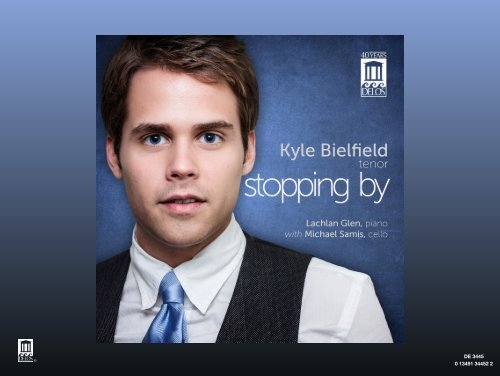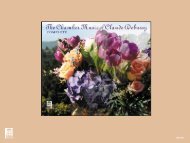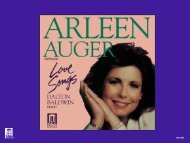Download the Digital Booklet - Delos Productions, Inc.
Download the Digital Booklet - Delos Productions, Inc.
Download the Digital Booklet - Delos Productions, Inc.
Create successful ePaper yourself
Turn your PDF publications into a flip-book with our unique Google optimized e-Paper software.
DE 34450 13491 34452 2
STOPPING BYKyle Bielfield, tenor; Lachlan Glen, piano • with Michael Samis, cello1. Amy Beach: Autumn Song 1:452. Samuel Barber: Stopping by Woods on a Snowy Evening 2:003. Ned Rorem: The Lordly Hudson 2:274. John Duke: Water That Falls and Runs Away 2:115. Charles Griffes: The Water-Lily 2:366. Elliott Carter: The Rose Family 1:177. Paul Bowles: In <strong>the</strong> Woods 1:478. Samuel Barber: Sure On This Shining Night 2:309. John Duke: Stopping by Woods on a Snowy Evening 3:3610. Ned Rorem: Snake 1:0611. Charles Wakefield Cadman: Sky Blue Water 1:5612. John Duke: Morning in Paris 1:5713. Charles Griffes: Phantoms 2:0014. John Duke: Bread and Music 3:0315. John Duke: Little Elegy 1:5316. John Duke: Wood Song 1:3017. John Duke: February Twilight 2:3018. Celius Dougherty: Beauty Is Not Caused 2:1219. Ned Rorem: Stopping by Woods on a Snowy Evening 2:2420. Amy Beach: Go Not Too Far 1:5321. Mark Abel: The Benediction 7:0722. Aaron Copland: Simple Gifts 2:0223. Aaron Copland: Long Time Ago 2:4624. Stephen Foster: Beautiful Dreamer 3:0325. Stephen Foster: Gentle Annie 2:3926. Irving Berlin: Change Partners 3:4427. Leonard Bernstein: Spring Will Come Again 3:3928. Leonard Bernstein: Dream with Me 4:21Total Playing Time: 71:54Producers: Kira Bielfield Williams, Kevin EdlinExecutive Producer: Carol RosenbergerRecording, Editing, Mixing: Kevin EdlinMastering: Mat<strong>the</strong>w SnyderCover Photo: Nick GaswirthLayout: Mark EvansPhoto Credits: Nick Gaswirth, Jordan Chlapecka, Dean Dixon, Harold Levine,Lindsay KoobRecorded at First United Methodist Church, Murfreesboro, TN, March 8, 9, 11,16, 2013The Artists Wish To Thank <strong>the</strong> followingindividuals: Bruce and Sandy Bielfield; Patrick Mat<strong>the</strong>ws; Elliott Peterson, Music Director at FUMC; RalphScott; Chris Purdy; Mark Abel; Edith Bers; Steven Blier; Gus Chrysson; Margo Garrett; Kathryn LaBouff;Mollie Nichols; Carol Rosenberger; Bruce Saylor; Gregory Sheppard; Kira Williams; Reed Woodhouse; BrianZeger; J.J. Penna; Diane Richardson; Min Kwon; Elizabeth Green; Marilyn Meier-Kapavale; Hea<strong>the</strong>r Bieman;Maria Cartwright; Chris, Leanne and Meaghan Glen; Carla, Alastair and An<strong>the</strong>a Wilson; Geoff and MarjorieCarpenter; Rev. Arthur Bridge; Hazel McMillan; Michael and Coralie Flint; Rhondda Hamilton7 & W 2013 <strong>Delos</strong> <strong>Productions</strong>, <strong>Inc</strong>., P.O. Box 343, Sonoma, California 95476-9998(707) 996-3844 • contactus@delosmusic.com • (800) 364-0645 • Made in USA • www.delosmusic.com
NOTES ON THE PROGRAMIn this, emerging tenor Kyle Bielfield’s debut recording,we are treated to a choice array of American songs bothwell-known and obscure, ranging from <strong>the</strong> earliest publisheddomestic songs by Stephen Foster to selectionsby remarkable living composers like icon Ned Roremand recently discovered Mark Abel. All of <strong>the</strong> texts, aswell, are by American poets. While <strong>the</strong> program favorsmore classically-oriented art songs (21 of <strong>the</strong>m), <strong>the</strong>program’s final seven pieces – by Foster, Aaron Copland,Irving Berlin and Leonard Bernstein – fall more into<strong>the</strong> category of classic Americana. The album’s central<strong>the</strong>me lies in its three different settings of beloved formerAmerican Poet-Laureate Robert Frost’s “Stoppingby Woods on a Snowy Evening,” arguably our nation’sbest-known single poem; a work that Frost himselfcalled “…my best bid for remembrance.”While several of <strong>the</strong> composers here are represented bymultiple songs (up to seven apiece), we have chosen notto block each tunesmith’s efforts toge<strong>the</strong>r in <strong>the</strong> recording,opting instead to sequence <strong>the</strong> entire program withcontrasting moods and tempi in mind, so as to make fora well-balanced and engaging listening experience overall.The following notes will cover <strong>the</strong> particulars of eachcomposer’s life and representative works toge<strong>the</strong>r in single,all-inclusive paragraphs. In order to convey a senseof running history, <strong>the</strong> composers will be discussed inchronological order, by date of birth.What survey of American song would be complete withoutmusic by our national songwriting pioneer, StephenFoster (1826-1864)? Often called “<strong>the</strong> Fa<strong>the</strong>r of AmericanMusic,” Foster composed over 200 songs in <strong>the</strong>course of his tragically short life – dozens of which remainwidely known and cherished. Two of his mostbeloved and sentiment-drenched efforts are heard here.“Beautiful Dreamer” (track 24) enchants, with its bewitchingsense of gentle reverie. The wistfully melancholicaura of “Gentle Annie” (tr 25) – here enhancedwith solo cello passages – rarely fails to bring tears tolisteners’ cheeks.Amy Beach (1867-1944) – America’s first woman composerto achieve lasting success (also as a performingmusician) – got off to a fairly late professional start, asher tradition-minded husband restricted her musical ac-
tivities severely. Among o<strong>the</strong>r compositions in widelyvaried genres, her song output numbers around 150.Her “Autumn Song” (tr 1) – ironically setting a text byher husband – is a marvel of pensive musing over <strong>the</strong>approach of winter. “Go Not too Far” (tr 20) is a lovesong of exquisitely dreamy tenderness.Charles Wakefield Cadman (1881-1946) was a fine composerin multiple genres (including film) whose work wasoften critically disparaged due to his early associationwith Native American music – which he had actively collectedon primitive cylinder recordings for <strong>the</strong> SmithsonianInstitution early in <strong>the</strong> 20th Century. But his fairlysimple, yet attractive American Indian-influenced songheard here – “From <strong>the</strong> Land of <strong>the</strong> Sky-Blue Water” (tr11) actually helped to refurbish his reputation when a famoussoprano of his day, Lillian Nordica, added it to herperforming repertoire at a time when everything “wildwest”was all <strong>the</strong> public rage.first domestic composer to compose music of exotically“foreign” sound and style in <strong>the</strong> Impressionist manner.Among 26 published songs, his elegantly languid “TheWater-Lily” (tr 5) is a memorable tone painting of <strong>the</strong>subject flower, while his cool and mystic-toned “Phantoms”(tr 13) evokes <strong>the</strong> wintry shades of summer’s lostgreenery and <strong>the</strong> lurking spirit of impending springtime.Irving Berlin (1888-1989) – <strong>the</strong> son of Belorussian Jewishimmigrants – survived a poverty-ridden New Yorkchildhood to achieve early success as a Tin Pan Alleysongwriter, on a par with greats like Gershwin and ColePorter. While he is primarily considered a creator of musicalAmericana, future generations may well rank hisbest pieces among <strong>the</strong> finest of American art songs.Among his seemingly countless classic hits is thisrecording’s glowing rendition of “Change Partners” (tr26), a gently wistful love-ballad of subdued longing andsadly quiet jealousy.Ano<strong>the</strong>r American genius who died too soon wasCharles Tomlinson Griffes (1884-1920). Trained in Berlin,he came under <strong>the</strong> influence of eclectic composers likeRussia’s Scriabin, as well as <strong>the</strong> French Impressionists.After his return to America, he went on to become <strong>the</strong>John Duke (1899-1984) both performed and taught as arenowned pianist, yet <strong>the</strong> bulk of his output as a composerwere his 265 art songs. When asked why, he answered,“I think it is because of my belief that vocalutterance is <strong>the</strong> basis of music’s mystery.” The seven
examples heard in this collection (far more than fromany o<strong>the</strong>r composer) stand as convincing evidence ofDuke’s rare achievements as a creator of art songs.“Water that Falls and Runs Away” (tr 4) is an ecstaticallywonder-struck piece with a brilliant, yet “liquid” pianoaccompaniment. His take on “Stopping by Woods on aSnowy Evening” (tr 9) is especially mysterious, withpearly piano tones evoking <strong>the</strong> aimless drifting ofsnowflakes. Feelings of bracing contentment and youthfuloptimism come with “Morning in Paris” (tr 12).“Bread and Music” (tr 14) and “Little Elegy” (tr 15)brea<strong>the</strong> <strong>the</strong> wistful sadness and desolation of lost love.“Wood Song” (tr 16) and “February Twilight” (tr 17) bothradiate <strong>the</strong> wonders and healing powers of nature.nostalgic strains of “Long Time Ago” (tr 23) seem to recall<strong>the</strong> sweetly sentimental spirit of Stephen Foster.Celius Dougherty (1902-1986) studied piano and compositionat Juilliard, and was primarily active as a pianist;he often toured as an accompanist with legendarysingers like Marian Anderson and Alexander Kipnis. Heleft us an opera and a handful of instrumental works, bu<strong>the</strong> is remembered chiefly as a composer of nearly 200art songs – which are remarkable for <strong>the</strong>ir well-craftedstructure, tasteful elegance, and imaginative piano accompaniments.The ecstatically philosophical strains of“Beauty is Not Caused” (tr 18) – an Emily Dickinson setting– is a prime example of his art song style.While Aaron Copland (1900-1990) is best known by farfor capturing <strong>the</strong> deepest essence of America in hisunique and often programmatic “yankee” art, musiciansand historians also treasure his beautifully crafted absolutemusic that came in <strong>the</strong> wake of his early studieswith Nadia Boulanger in Paris. His most popular examplesof vocal Americana include “Simple Gifts” (tr 22),his setting of <strong>the</strong> ubiquitous Shaker hymn-tune that firstappeared in his Appalachian Spring ballet score andsubsequent orchestral suite. The lovely and intenselyElliott Carter (1908-2012) – known towards <strong>the</strong> end of hisvery long and productive life as “<strong>the</strong> dean of Americancomposers” – experimented with a wide variety of compositionalstyles and rhythmic/harmonic approaches over<strong>the</strong> years. While he produced quite a few vocal settings,his catalog includes only five actual art songs. A morecontemporary sort of idiom than we hear from most of<strong>the</strong> o<strong>the</strong>r composers represented here comes with “TheRose Family” (tr 6), a delightful setting of Robert Frost’swhimsical verse that gave Carter <strong>the</strong> chance to exercise
his often-cited senses of musical wit and humor.Next to Copland, Samuel Barber (1910-1981) no doubtremains <strong>the</strong> best-known and most beloved Americancomposer of his day. The disarming emotional directnessand intensity of his neo-romantic approach has nevergone out of fashion, and has made him a strong influenceupon subsequent generations of American tunesmiths.While not one of his best-known art songs, his exceptionallywarm and simple setting of Frost’s chilly “Stopping byWoods on a Snowy Evening” text (tr 2) is a real treat. ButBarber is revealed at his very best in his radiantly ecstatic,heaven-struck “Sure On this Shining Night” (tr 8) – whichalso exists in his sublime choral setting.Paul Bowles (1910-1999) was an American expatriatecomposer and writer who spent most of his adult life inTangier. His highly worthwhile, yet long-obscure musichas begun attracting renewed attention in recentdecades. His softly pensive “In <strong>the</strong> Woods” (tr 7) typifieshis conviction that “singing, it seems to me, shouldbe an extension of speech,” with as little distortion oftypical speaking patterns as possible. The setting isra<strong>the</strong>r unique in that Bowles calls upon his singers toactually whistle a sad little snippet of birdsong at twopoints in <strong>the</strong> piece.Leonard Bernstein (1918-1990) was no doubt America’smost brilliantly gifted, versatile and accomplished allaround20th-century musician – active as a conductor,pianist and composer. At home in many corners ofAmerica’s musical life, he not only brought classicalcomplexity to Broadway, but was a pioneer in suffusinghis classical efforts with <strong>the</strong> best of <strong>the</strong> domestic popscene’s jazzy jive. A later revision (and recording) ofBernstein’s relatively little-known 1950 musical, PeterPan, contains some of his finest songs – and it is withtwo of <strong>the</strong>se (performed here with cello) that <strong>the</strong> albumends. The softly blues-tinged “Spring Will Come Again”(tr 27) was apparently written for a 1964/65 musicaladaptation of Thornton Wilder’s The Skin of Our Teeththat never materialized; so Bernstein – never one towaste a good song – added it to Peter Pan. Here, it givesway to <strong>the</strong> magical reverie of “Dream With Me” (tr 28).Ned Rorem (b. 1923), while he has composed prolificallyin many genres, remains best-known for his wonderfulsongs, which invariably display his special knack for ut-
ARTIST BIOGRAPHIESKyle Bielfield, acclaimed as an “…outstanding soloist … singing superblyand acting with intensity” (The New York Times), is an American tenor whosecareer ranges from opera to art song. Bielfield has performed in such prestigiousvenues as Carnegie Hall, Alice Tully Hall, Avery Fisher Hall, and MerkinHall in New York.A graduate of The Juilliard School, (MM ’13), and New York University, (BM’09), Bielfield has received several notable awards,including <strong>the</strong> Juilliard Honors Recital in Alice TullyHall. He has performed in concert, productions,workshops, and galas with The Metropolitan Opera,New York City Opera, New York Festival of Song,American Lyric Theater, Center City Opera, BalletOpera Pantomime of Montreal, The Florida GrandOpera, and Juilliard Opera.Kyle has premiered several new works, includingColin Mat<strong>the</strong>w’s concert piece “No Man’s Land” inAlice Tully Hall for <strong>the</strong> 2013 Focus! Festival. O<strong>the</strong>rpremieres include collaborations with AmericanOpera Projects and Center City Opera. New worksKyle Bielfieldinclude a Metropolitan Opera Workshop of a newopera, The Sorrows of Frederick, by composer Scott Wheeler and librettistRomulus Linney; a production of The Golden Ticket with ALT at LincolnCenter. Fur<strong>the</strong>rmore, he participated in a special collaboration with <strong>the</strong>Chicago Department of Cultural Affairs as a narrator in Prokofiev’s The Lovefor Three Oranges, which debuted <strong>the</strong>re in 1927.Kyle Bielfield’s operatic roles include <strong>the</strong> madwoman in Curlew River,Ernesto in Don Pasquale, Dorvil in La Scala Di Seta, Le Chevalier Danois inArmide, Le Théière in L’enfant et les Sortileges, Pluto in Orpheus in <strong>the</strong> Underworld,and Brighella in Ariadne auf Naxos. His concert repertoire includesHandel’s Messiah and My Love Shall be Alway, Bach’s Wachet Auf, Mozart’sRequiem, Pergolesi’s Magnificat, Schutz’s Passion (Evangelist), Bernstein’sMass, and Saint-Saëns’ Oratorio de Noël.No stranger to charitable, cause-based performance, Bielfield has participatedin many community music projects. Most recently, with <strong>the</strong> Weill-CornellMusic and Medicine Initiative, he appeared as <strong>the</strong> tenor soloist in Mozart’s Requiemat St. Bartholomew’s Church. The initiative’s performance raised over$10,000 to secure medical care for uninsured New Yorkers. www.bielfield.comHighly versatile Australian artist Lachlan Glen is already gaining internationalrecognition as a pianist, accompanist, chamber musician, vocal coach andconductor. Recent engagements have taken him throughout Australia, Europeand <strong>the</strong> United States; he has appeared at prestigious venues like NewYork’s Carnegie Weill Recital Hall and Alice Tully Hall. A graduate of RutgersUniversity (B.M. ‘11, Piano Performance) and The Juilliard School (M.M. ‘13,Collaborative Piano), he is currently a member of <strong>the</strong> Lindemann Young ArtistDevelopment Program at New York’s MetropolitanOpera as he pursues his multifaceted career.Born in Sydney, Australia in 1989, Glen’s early interestin composition resulted in several national awards anda public performance of his orchestral work, DaintreeOverture. Alongside early viola studies, he performedas orchestral keyboardist and percussionist with<strong>the</strong> Penrith Symphony Orchestra and <strong>the</strong> Fisher’sGhost Youth Orchestra. More recently, Lachlan hasperformed as a soloist with various ensemblesthroughout Australia, Europe and <strong>the</strong> US – including<strong>the</strong> Wiener Residenzorchester and several RutgersUniversity ensembles – in works includingLachlan Glen
Liszt’s Piano Concerto No. 1. Among o<strong>the</strong>r awards, he has won prizes inseveral competitions, including <strong>the</strong> 2009 Sou<strong>the</strong>rn Highlands InternationalPiano and <strong>the</strong> 2008 Werner Baer Memorial Competitions. He has receivedprestigious fellowships and scholarships at Rutgers and Juilliard – as well asseveral notable grants and honor society memberships.Glen’s o<strong>the</strong>r activities include working with contemporary musicians like Italiancomposer Alberto Caruso and Canadian pop singer Rufus Wainwright.As a vocal coach and rehearsal pianist, he has worked with JamesLevine, Lorin Maazel, Richard Bonynge, Stephen Lord and Roger Bart. Hehas served on <strong>the</strong> staff and faculties of <strong>the</strong> Castleton Festival (VA),<strong>the</strong> Chautauqua Institution (NY) and <strong>the</strong> Internationale MeistersingerAkademie (Germany). He is <strong>the</strong> Founder and co-Artistic Director of Schubert& Co., a NYC festival that presented, in its inaugural season (2012-’13), <strong>the</strong>complete solo Lieder of Franz Schubert in a series of 35 recitals featuringover 70 singers and 10 pianists. An avid culinary and literary amateur, healso enjoys writing and has been a contributor to The Juilliard Journal.www.lachlanglen.netRecognized for his “shining and expressive” playing (The Tennessean),“confidence, conviction and precision” (ArtsNash), and “haunting tone” (TheCincinnati Post), Michael Samis is an accomplishedsolo, chamber and orchestral cellist. He is a 1999graduate of <strong>the</strong> Cleveland Institute of Music.O<strong>the</strong>r career highlights include performing as Principal Cellist under HelmuthRilling, with <strong>the</strong> New York String Orchestra at Carnegie Hall. Samis hasperformed in numerous music festivals around <strong>the</strong> world, including <strong>the</strong>Sarasota and Kent/Blossom chamber music festivals – also <strong>the</strong> PacificMusic Festival in Japan, where he sat Principal Cello under <strong>the</strong> baton ofMichael Tilson Thomas.Michael has been a member of <strong>the</strong> Nashville Symphony since 1999, currentlyserving as Assistant Principal Cello. In addition, he is Co-Principal Cellist of<strong>the</strong> GRAMMY ® -nominated Gateway Chamber Orchestra. He frequently performson National Public Radio affiliate WPLN’s Live in Studio C program,both as soloist and with chamber groups. He performed extensively with <strong>the</strong>Alexis Piano Trio from 1992 to 2001, and has given solo recitals at VanderbiltUniversity, Middle Tennessee State University and <strong>the</strong> Taft Museum of Art inCincinnati. He is <strong>the</strong> recipient of <strong>the</strong> Tennessee Arts Commission IndividualArtist Fellowship in Music for Solo Instrumental Performance.Michael Samis has served as Adjunct Professor of Cello at Middle TennesseeState University. A strong supporter of music education and advocacy,he has designed an educational program for string quartet, which heand his colleagues present in schools as part of <strong>the</strong> Nashville Symphony’s“Ensembles in <strong>the</strong> Schools” initiative. He believes in <strong>the</strong> healing power ofmusic and volunteers his time to play for hospice and hospital patients and<strong>the</strong>ir families. www.michaelsamis.comMichael SamisSamis performed Dvorak’s Cello Concerto with <strong>the</strong>Cincinnati Symphony Orchestra at age 17. O<strong>the</strong>r soloperformances include Haydn’s Cello Concerto in CMajor with <strong>the</strong> Nashville Philharmonic Orchestra,Elgar’s Cello Concerto with <strong>the</strong> Bryan Symphony Orchestra,and romantic-era composer Carl Reinecke’sforgotten Cello Concerto with <strong>the</strong> Gateway ChamberOrchestra (U.S. Premiere); Samis has recentlyrecorded this work to be featured in his debut soloalbum scheduled for release on <strong>Delos</strong> in 2014.Lachlan Glen, Michael Samis, Kyle Bielfield




